
Yamaha XS 650
Encyclopedia
The XS650 is a mid-size motorcycle
made by Yamaha Motor Company
. The standard model was introduced in 1968 and produced through 1979. The "Special" cruiser model was introduced in 1978 and produced through 1985. The XS650 began with the 1955 Hosk SOHC 500 twin
. After about 10 years of producing 500 twin, Hosk engineers designed a 650 cc twin. Later the Hosk was acquired by Showa Corporation
, and in 1960 Yamaha had bought Showa with Hosk's early design of 650 cc twin.
When the Yamaha XS 650 was launched in 1968 it had one of the most advanced engines
in its class of large parallel twin motorcycles. The engine and gearbox
are unit construction
with the crankcase
split horizontally for ease of assembly whereas almost all contemporaries in its class in 1968 are either unit construction with a vertically-split crankcase or pre-unit construction
with separate engine and gearbox. The XS650s engine was used in AMA Professional Dirt Track Racing by national champion Kenny Roberts. In 1968 only the Laverda 750S, also launched that year, matched the XS 650's modernity of unit construction and SOHC valve operation.
The first two model years (XS-1 and XS-1B) were kick start only, with an electric starter added from the 1972 model year on. This had a compression release
added to the front left exhaust tappet cover resulting in a square versus triangular cover found on the other exhaust and intake covers. Upon removal of the compression release mechanism in 1974 due to uprated starter, the square cover at the left exhaust valve was continued.
Except that:
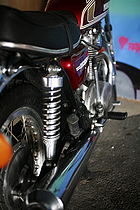 Handling differences on swapping rear wheels:-
Handling differences on swapping rear wheels:-
Mid-'77 the front forks had a major redesign, fork tube diameter increased from 34 to 35 mm (1.4 in) and internals were changed (although this also holds true for various years of the same tube size). The entire fork assembly (with triple tree) will swap either way but fork parts are not equivalent. Also the brake caliper changed from a 48 mm (1.9 in) dual piston cast iron design for the 34 mm (1.3 in) fork to a 40 mm (1.6 in) aluminum single piston floating caliper for the 35 mm (1.4 in) forks. The brake caliper mounting lugs on the fork sliders are of different spacing for the 34 mm (1.3 in) and 35 mm (1.4 in) forks so the calipers can't be swapped.
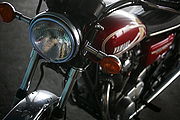 The XS 650 was produced until 1985. The last model year was 1983 in the United States, with Canada, Europe and other markets continuing into 1984 and 1985. However, many US models were left over due to overproduction and an economic recession and brand new 1982 and 1983 models could still be purchased in 1987 at some dealerships.
The XS 650 was produced until 1985. The last model year was 1983 in the United States, with Canada, Europe and other markets continuing into 1984 and 1985. However, many US models were left over due to overproduction and an economic recession and brand new 1982 and 1983 models could still be purchased in 1987 at some dealerships.
, but also generates some vibration
caused by the two piston
s rising and falling together. This vibration is particularly noticeable at idle
.
The XS 650s valves are operated by a single overhead camshaft
(SOHC) whereas almost all contemporaries in its class have pushrod
valvegear.
The 360 degrees crankshaft uses three roller bearings and a ball bearing. The camshaft uses four ball bearings, and rolling bearings are used throughout the rest of the engine. Connecting rods turn on needle bearings. Since the engine is SOHC, there are no pushrods to operate the valves. The camshaft gets its drive from a single-row chain running from the center of the crankshaft. Chain is maintained by a spring-loaded guide, which also takes up unnecessary slack. The intake valve opens 47 degrees BTC, closes 67 degrees ATC, yielding intake duration of 294 degrees, exhaust duration on 281 degrees, and an overlap of 88 degrees. Because the flywheel
is lighter, the engine tends to pick up revs rapidly when the throttle is opened quickly.
During the later developments of the engine compression ratios were lowered, then raised. Pistons were lightened 20 percent along with connecting rods to reduce the reciprocating mass inside the engine. Aluminum pistons are slightly domed with valve pockets. Pistons have three rings installed, two compression and one oil control ring.
Horizontal split of the crankcases offers the advantages of oil tightness through the elimination of vertical joints and one-step access to both the lower end and the gearbox. Oil pressure is provided by the trochoidal pump, driven by a steel spur gear off the crankshaft. The main bearings, crank pins, transmission main shaft, clutch
bushing, shifter fork guide bar, and rocker arms are lubricated by pressurized oil, whereas the rest of the engine is lubricated by “oil splash.”
Mikuni
carburetors that can be tuned by moving the needle clip position, or by replacing jets. In the carburetors the velocity of the fuel mixture through the venturi, regulated by the opening of the butterfly valves and engine speed, causes a pressure difference between the top and the bottom of the carburetor pistons. This pressure difference raises and lowers the pistons.
Post-1979 models use smaller 34 mm (1.3 in) Mikuni CV carbs with needles that seem to be listed in parts menus as being 'fixed' position,(in other words a needle that may only have one clip position). The pilot and main jets can be changed for different sizes. If the 34 mm (1.3 in) CV carb needles only have one fixed clip position.
As previously noted, of '81-'83 models using; Hitachi
carburetors with all jets pressed in place. That was not correct for the XS650s. That is true for the later model, '80-on, XS[850] triples, Yamaha's three cylinder 750/850 model.
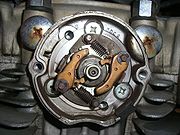
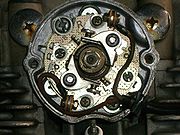
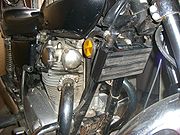
Motorcycle
A motorcycle is a single-track, two-wheeled motor vehicle. Motorcycles vary considerably depending on the task for which they are designed, such as long distance travel, navigating congested urban traffic, cruising, sport and racing, or off-road conditions.Motorcycles are one of the most...
made by Yamaha Motor Company
Yamaha Motor Company
, is a Japanese motorized vehicle-producing company. Yamaha Motor is part of Yamaha Corporation and its headquarter is located in Iwata, Shizuoka. Along with expanding Yamaha Corporation into the world's biggest piano maker, then Yamaha CEO Genichi Kawakami took Yamaha into the field of motorized...
. The standard model was introduced in 1968 and produced through 1979. The "Special" cruiser model was introduced in 1978 and produced through 1985. The XS650 began with the 1955 Hosk SOHC 500 twin
Straight-two
A straight-two engine, is a two-cylinder piston engine that has its cylinders arranged side by side....
. After about 10 years of producing 500 twin, Hosk engineers designed a 650 cc twin. Later the Hosk was acquired by Showa Corporation
Showa Corporation
is a manufacturer of high-performance automotive, motorcycle and outboard suspension systems based in Gyoda, Saitama in Japan.Founded in October 1938 in Japan's drive to develop its military capability in preparation for World War II, Showa supplied aircraft suspension and landing systems to...
, and in 1960 Yamaha had bought Showa with Hosk's early design of 650 cc twin.
When the Yamaha XS 650 was launched in 1968 it had one of the most advanced engines
Reciprocating engine
A reciprocating engine, also often known as a piston engine, is a heat engine that uses one or more reciprocating pistons to convert pressure into a rotating motion. This article describes the common features of all types...
in its class of large parallel twin motorcycles. The engine and gearbox
Transmission (mechanics)
A machine consists of a power source and a power transmission system, which provides controlled application of the power. Merriam-Webster defines transmission as: an assembly of parts including the speed-changing gears and the propeller shaft by which the power is transmitted from an engine to a...
are unit construction
Unit construction
Unit construction is a term used to describe the design of larger motorcycles where the engine and gearbox components share a single casing. The term is sometimes applied to the design of automobile engines and was often loosely applied to motorcycles with rather different internal layouts such as...
with the crankcase
Crankcase
In an internal combustion engine of the reciprocating type, the crankcase is the housing for the crankshaft. The enclosure forms the largest cavity in the engine and is located below the cylinder, which in a multicylinder engine are usually integrated into one or several cylinder blocks...
split horizontally for ease of assembly whereas almost all contemporaries in its class in 1968 are either unit construction with a vertically-split crankcase or pre-unit construction
Pre-unit construction
Pre-unit construction, also called separate construction, is a motorcycle engine architecture where the engine and gearbox are separate casings, with their own oil reservoirs, and usually attached to parallel plates that also attach to the frame...
with separate engine and gearbox. The XS650s engine was used in AMA Professional Dirt Track Racing by national champion Kenny Roberts. In 1968 only the Laverda 750S, also launched that year, matched the XS 650's modernity of unit construction and SOHC valve operation.
Model history
The 1970 model was designated the XS-1. Subsequent models were XS-1B (1971), XS-2 (1972), then TX (1973), TX-A (1974), XS-B (1975), XS-C (1976), XS-D (1977), XS-E (1978), XS-F (1979). 1979 was the last year of the so-called "Standards" (owner's term meaning opposite to the 650 "Special," which had pullback bars, teardrop tanks, and other custom features). The Es and Fs also came in Special form: XS-SE (S for Special) and XS-SF. From then on they were Specials only to XS-SG, XS-SH, XS-SJ, XS-SK. There was a Special II (Two) model designation in 1979 (XS-SF-II), 1980 (XS-G), 1981 (XS-H) which were models with fewer chrome parts and drum rear brake (1979, 1980) or wire wheels (1981) versus disc rear brake or cast wheels.The first two model years (XS-1 and XS-1B) were kick start only, with an electric starter added from the 1972 model year on. This had a compression release
Compression release
A compression release mechanism works to ease the starting of internal combustion engines by allowing them to spin up to starting speed without having to work against the pumping action of the pistons...
added to the front left exhaust tappet cover resulting in a square versus triangular cover found on the other exhaust and intake covers. Upon removal of the compression release mechanism in 1974 due to uprated starter, the square cover at the left exhaust valve was continued.
Except that:
- Drum fronts on early models are on their own.
- Pre '77 & post '77 fronts have different (offset) brake discs, the wheels swap but not the discs.
- Drum rear wheel into rear disc frame needs the rear drum frame swingarmSwingarmA swingarm, or "swinging arm" is the main component of the rear suspension of most modern motorcycles and ATVs...
too. - Disk rear wheel into rear drum frame needs the rear disc frame swingarm and also needs brake master-cylinder lugs welded to the frame.

- Standard rear tire is 110/90-18. Special rear tire is 130/90-16. Because the Standard tire is narrower it corners more quickly. Because the Special tire is wider it is steadier in a straight line. Overall gearing is not changed from the Standard, as the two tires are essentially the same outside diameter.
Mid-'77 the front forks had a major redesign, fork tube diameter increased from 34 to 35 mm (1.4 in) and internals were changed (although this also holds true for various years of the same tube size). The entire fork assembly (with triple tree) will swap either way but fork parts are not equivalent. Also the brake caliper changed from a 48 mm (1.9 in) dual piston cast iron design for the 34 mm (1.3 in) fork to a 40 mm (1.6 in) aluminum single piston floating caliper for the 35 mm (1.4 in) forks. The brake caliper mounting lugs on the fork sliders are of different spacing for the 34 mm (1.3 in) and 35 mm (1.4 in) forks so the calipers can't be swapped.
End of production

Motorcycle model ID table
| Model | Code | Serial Number | Year | Color(s) |
|---|---|---|---|---|
| XS1 | 256 | S650-000101 | 1970 | Candy Green |
| XS1B | 256 | S650-007101 | 1971 | Candy Orange |
| XS2 | 306 | S650-100101 | 1972 | Brilliant Red |
| TX650 | 366 | S650-200101 | 1973 | Metallic Flake Blue |
| TX650A | 447 | 447-000101 | 1974 | Cinnamon Brown |
| XS650B | 533 | 447-100101 | 1975 | Star Black |
| XS650C | 584 | 447-200101 | 1976 | French Blue |
| XS650D | 1T3 | 447-700101 | 1977 | Maxi Maroon, Bountiful Blue |
| XS650E | 2F0 | 2F0-000101 | 1978 | Star Black, Spruce Metallic Green |
| XS650SE | 2M0 | 2F0-100101 | 1978 | Vintage Burgundy, New Midnight Black |
| XS650F | 2F0 | 2F0-150101 | 1979 | Cobalt Blue |
| XS650SF | 2M0 | 2F0-250101 | 1979 | Carmine Red, Black Gold |
| XS650-2F | 3N0 | 4F0-250101 | 1979 | New Yamaha Black |
| XS650G | 3G0 | 3G0-000101 | 1980 | Black Gold |
| XS650SG | 3G1 | 2F0-200101 | 1980 | Cardinal Red, New Yamaha Black |
| XS650H | 4N9 | 4N9-000101 | 1981 | Indigo Blue, New Ruby Red |
| XS650SH | 4M4 | 4M4-000101 | 1981 | New Yamaha Black, Frost Silver |
| XS650SJ | 5V4 | 5V4-000101 | 1982 | New Yamaha Black |
| XS650SK | 5V4 | 5V4-100101 | 1983 | New Yamaha Black, New Ruby Red |
Engine
Like its contemporaries in its class the XS 650 has a 360° crank angle. This provides an even firing interval between the two cylindersCylinder (engine)
A cylinder is the central working part of a reciprocating engine or pump, the space in which a piston travels. Multiple cylinders are commonly arranged side by side in a bank, or engine block, which is typically cast from aluminum or cast iron before receiving precision machine work...
, but also generates some vibration
Engine balance
Engine balance is the design, construction and tuning of an engine to run smoothly. Improving engine balance reduces vibration and other stresses and can improve the overall performance, efficiency, cost of ownership and reliability of the engine, as well as reducing the stress on other machinery...
caused by the two piston
Piston
A piston is a component of reciprocating engines, reciprocating pumps, gas compressors and pneumatic cylinders, among other similar mechanisms. It is the moving component that is contained by a cylinder and is made gas-tight by piston rings. In an engine, its purpose is to transfer force from...
s rising and falling together. This vibration is particularly noticeable at idle
Idle
Idle is a term which generally refers to a lack of motion and/or energy.- Uses :In describing a person or machine, idle means the act of nothing or no work...
.
The XS 650s valves are operated by a single overhead camshaft
Overhead camshaft
Overhead cam valvetrain configurations place the engine camshaft within the cylinder heads, above the combustion chambers, and drive the valves or lifters in a more direct manner compared to overhead valves and pushrods...
(SOHC) whereas almost all contemporaries in its class have pushrod
Overhead valve
An overhead valve engine, also informally called pushrod engine or I-head engine, is a type of piston engine that places the camshaft within the cylinder block , and uses pushrods or rods to actuate rocker arms above the cylinder...
valvegear.
The 360 degrees crankshaft uses three roller bearings and a ball bearing. The camshaft uses four ball bearings, and rolling bearings are used throughout the rest of the engine. Connecting rods turn on needle bearings. Since the engine is SOHC, there are no pushrods to operate the valves. The camshaft gets its drive from a single-row chain running from the center of the crankshaft. Chain is maintained by a spring-loaded guide, which also takes up unnecessary slack. The intake valve opens 47 degrees BTC, closes 67 degrees ATC, yielding intake duration of 294 degrees, exhaust duration on 281 degrees, and an overlap of 88 degrees. Because the flywheel
Flywheel
A flywheel is a rotating mechanical device that is used to store rotational energy. Flywheels have a significant moment of inertia, and thus resist changes in rotational speed. The amount of energy stored in a flywheel is proportional to the square of its rotational speed...
is lighter, the engine tends to pick up revs rapidly when the throttle is opened quickly.
During the later developments of the engine compression ratios were lowered, then raised. Pistons were lightened 20 percent along with connecting rods to reduce the reciprocating mass inside the engine. Aluminum pistons are slightly domed with valve pockets. Pistons have three rings installed, two compression and one oil control ring.
Horizontal split of the crankcases offers the advantages of oil tightness through the elimination of vertical joints and one-step access to both the lower end and the gearbox. Oil pressure is provided by the trochoidal pump, driven by a steel spur gear off the crankshaft. The main bearings, crank pins, transmission main shaft, clutch
Clutch
A clutch is a mechanical device which provides for the transmission of power from one component to another...
bushing, shifter fork guide bar, and rocker arms are lubricated by pressurized oil, whereas the rest of the engine is lubricated by “oil splash.”
Carburetion
Pre-1980 models use the twin 38 mm (1.5 in) constant velocityVelocity
In physics, velocity is speed in a given direction. Speed describes only how fast an object is moving, whereas velocity gives both the speed and direction of the object's motion. To have a constant velocity, an object must have a constant speed and motion in a constant direction. Constant ...
Mikuni
Mikuni
is a leading Japanese carburettor manufacturing company that was founded in 1923 and incorporated in 1948. Their business activities are centred on carburettors, fuel injectors and other automobile related equipment...
carburetors that can be tuned by moving the needle clip position, or by replacing jets. In the carburetors the velocity of the fuel mixture through the venturi, regulated by the opening of the butterfly valves and engine speed, causes a pressure difference between the top and the bottom of the carburetor pistons. This pressure difference raises and lowers the pistons.
Post-1979 models use smaller 34 mm (1.3 in) Mikuni CV carbs with needles that seem to be listed in parts menus as being 'fixed' position,(in other words a needle that may only have one clip position). The pilot and main jets can be changed for different sizes. If the 34 mm (1.3 in) CV carb needles only have one fixed clip position.
As previously noted, of '81-'83 models using; Hitachi
Hitachi
Hitachi is a multinational corporation specializing in high-technology.Hitachi may also refer to:*Hitachi, Ibaraki, Japan*Hitachi province, former province of Japan*Prince Hitachi and Princess Hitachi, members of the Japanese imperial family...
carburetors with all jets pressed in place. That was not correct for the XS650s. That is true for the later model, '80-on, XS[850] triples, Yamaha's three cylinder 750/850 model.
Ignition
The models up to 1979 use points ignition. Two sets of points are located on the upper left of the cylinder head. On the right side cylinder head, an advance mechanism is located. And advance mechanism is used to retard the timing for easy starting and smooth idle. Post-1979 models use electronic ignition systems.

Performance
- Standing-start quarter= 13.86 sec at 96.05 mi/h
- Motorcycle average gas millage=51.4 mpg


